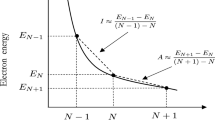Abstract
In this work, the third derivative of the energy with respect to the number of electrons, the so-called hyper-hardness, is investigated to assess whether this quantity has a chemical meaning. To achieve this goal a new working expression for hyper-hardness is developed and analyzed. It transpired from this analysis that hyper-hardness, just like hardness, can measure the reactivity or the stability of electron systems. Interestingly, positive values of hyper-hardness point to quite stable species such as noble gases and molecules. On the other hand, radicals almost always display large negative values of hyper-hardness.
Similar content being viewed by others
References
Pauling L (1932) J Am Chem Soc 54:3570–3582
Jensen MQ (1996) J Chem Educ 73:11
Iczkowski RP, Margrave JL (1961) J Am Chem Soc 83:3547–3551
Parr RG, Donelly RA, Levy M, Palke WE (1978) J Chem Phys 68:3801–3807
Geerlings P, De Proft F, Langenaeker W (2003) Chem Rev 103:1793–1873
Chermette H (1999) J Comput Chem 20:129–154
Parr RG, Pearson RG (1983) J Am Chem Soc 105:7512–7516
Pearson RG (1968) J Chem Educ 45:981–984
Pearson RG (1997) Chemical Hardness. Wiley-VCH, Weinheim
Chattaraj PK, Lee H, Parr RG (1991) J Am Chem Soc 113:1855–1856
Ayers PW, Parr RG, Pearson RG (2006) J Chem Phys 124:194107
Chattaraj PK, Ayers PW, Melin J (2007) Phys Chem Chem Phys 9:3853–3856
Pearson RG (1968) J Chem Educ 45:581–586
Huheey JE (1965) J Phys Chem 69:3284–3291
Huheey JE, Watts JC (1971) Inorg Chem 10:1553–1554
Politzer PJ (1987) Chem Phys 86:1072–1073
Politzer P, Huheey JE, Murray JS, Grodzicki MJ (1992) Mol Struct 259:99–120
Huheey JE (1971) J Org Chem 36:204–205
Morell C, Grand A, Toro-Labbé A (2005) J Phys Chem A 109:205–212
Morell C, Grand A, Toro-Labbé A (2006) Chem Phys Lett 425:342–346
Fuentealba P, Cedillo M (1999) J Chem Phys 110:9807–9811
Geerlings P, De Proft F (2008) Phys Chem Chem Phys 10:3028–3042
Chattaraj PK, Cedillo A, Parr RG (1995) J Chem Phys 103:7645–7646
Parr RG, Fuentealba P (1991) J Chem Phys 94:5559–5564
Senet P (1996) J Chem Phys 105:6471–6489
Senet P (1997) J Chem Phys 107:2516–2524
Dunlap BI (2008) J Chem Phys 129:244109
Parr RG, Yang W (1984) J Am Chem Soc 106:4049–4050
Morell C, Ayers PW, Grand A, Chermette H (2011) Phys Chem Chem Phys 13:9601–9608
De Proft F, Geerlings P, Liu S, Parr RG (1999) Polish J Chem 72:1737–1746
Berkowitz M, Parr RG (1988) J Chem Phys 88:2554–2557
Gutierrez-Oliva S, Jaque P, Toro-Labbé A (2000) J Phys Chem A 104:8955–8964
See for instance CRC Handbook of Chemistry and Physics, CRC Press
Giese B, He J, Mehl W (1988) Chem Ber 121:2063–2066
Heberger K, Lopata A (1998) J Org Chem 63:8646–8653
Wu JQ, Beranek I, Fisher H (1995) Helv Chim Acta 78:194–214
De Vleeschouwer F, Van Speybroeck V, Waroquier M, Geerlings P, De Proft F (2007) Org Lett 9:2721–2724
Acknowledgments
All the authors thank the joint program between “Evaluation-orientation de la Coopération Scientifique” and “Comisión Nacional de Investigación Científica y Tecnológica” (ECOS-CONICYT (through action project n°C11E03. C.M. and A.G. thank “le Commissariat à l’Energie Atomtique” (CEA-Grenoble) and “Grand Equipement National de Calcul Intensif” (GENCI) through projects gen6836 and gen6834 for computational support. A.T.L. acknowledges support from “Fondo Nacional de Desarrollo Científico y Tecnológico” (FONDECYT) through project n° 1090460. H.C gratefully acknowledges the “Grand Equipement National de Calcul Intensif./Centre Informatique National de l’Enseignemenet Supérieur” (GENCI/CINES) for HPC resources/computer time (Project cpt2130). Finally the authors specially thank the reviewer for pointing out the discrepancy in electronegativity values.
Author information
Authors and Affiliations
Corresponding author
Rights and permissions
About this article
Cite this article
Morell, C., Grand, A., Toro-Labbé, A. et al. Is hyper-hardness more chemically relevant than expected?. J Mol Model 19, 2893–2900 (2013). https://doi.org/10.1007/s00894-013-1778-z
Received:
Accepted:
Published:
Issue Date:
DOI: https://doi.org/10.1007/s00894-013-1778-z




